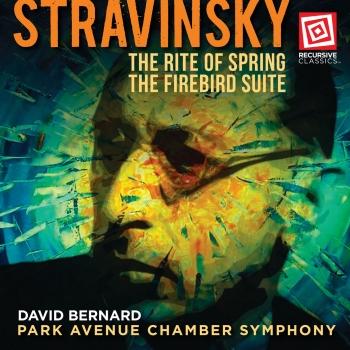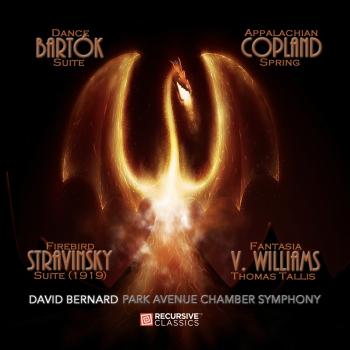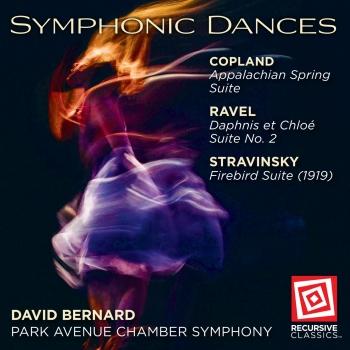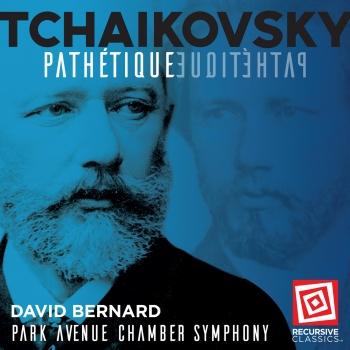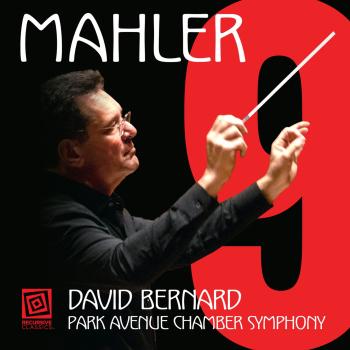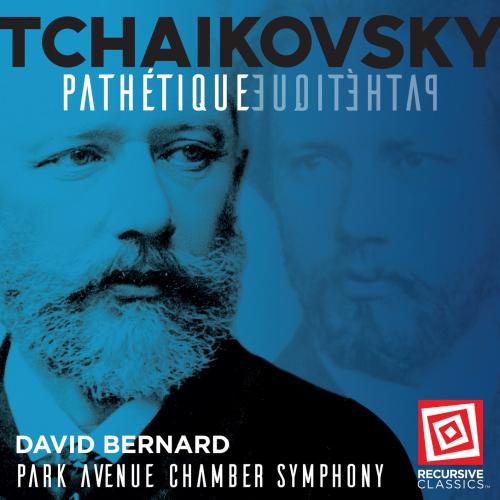
Tchaikovsky: Symphony No. 6 in B Minor, Op. 74, TH 30 "Pathétique" Park Avenue Chamber Symphony & David Bernard
Album info
Album-Release:
2018
HRA-Release:
09.03.2021
Label: Recursive Classics
Genre: Classical
Subgenre: Orchestral
Artist: Park Avenue Chamber Symphony & David Bernard
Composer: Piotr Ilyich Tchaikovsky (1840-1993)
Album including Album cover
- Pyotr Ilyich Tchaikovsky (1840 - 1893): Symphony No. 6 in B Minor, Op. 74, TH 30 "Pathétique":
- 1 Tchaikovsky: Symphony No. 6 in B Minor, Op. 74, TH 30 "Pathétique": I. Adagio - Allegro non troppo 18:09
- 2 Tchaikovsky: Symphony No. 6 in B Minor, Op. 74, TH 30 "Pathétique": II. Allegro con grazia 07:38
- 3 Tchaikovsky: Symphony No. 6 in B Minor, Op. 74, TH 30 "Pathétique": III. Allegro molto vivace 08:20
- 4 Tchaikovsky: Symphony No. 6 in B Minor, Op. 74, TH 30 "Pathétique": IV. Finale. Adagio lamentoso 11:06
Info for Tchaikovsky: Symphony No. 6 in B Minor, Op. 74, TH 30 "Pathétique"
Tchaikovsky toyed with the public on the meaning of his final symphony, proclaiming an underlying program existed, but refusing to disclose it. His death shortly after its premiere brought a perfect storm of mystery and intrigue, leaving an imaginative public to proclaim this work was his suicide note.
In this new Recursive Classics release, David Bernard brings a fresh look at Tchaikovsky s Pathétique . The circumstantial drama that surrounds the Pathétique can be an incentive for performers to see each and every phrase as an opportunity to express mournful longing a practice that isn t especially helpful to the work, says Bernard. And when considering the work as a whole, the suicide note theory that is used as the basis for this thinking is somewhat questionable. The Pathétique s immense scale and relentless passion demands a life force in the composer that simply could not exist inside a person resigned to take his own life.
Bernard sees the Pathétique as Tchaikovsky recalling his earlier works in a new-found artistic voice. You hear Tchaikovsky reimagining his life s work through a more mature and effective lens, says Bernard. The first movement s narrative shape is unmistakably linked to his Romeo and Juliet Fantasy Overture, requiring a balance between emotional depth and penetrating line in the well-known lyrical second theme, suddenly launching relentlessly driven episodes that bring us to a gut-wrenching largamente and a final retelling of the lyrical theme with an epilogue through which the energy of the movement is released. The second movement reimagines Tchaikovsky s ballet waltzes, requiring a flow that enables a light half note lifted pulse at the ends of each 5/4 measure, gliding the listener from beginning to end. The Third Movement s reconstitution of Tchaikovsky s symphonic finales requires an unceasing energy that drives relentlessly to an ending that is as inevitable as it is exciting. While the first three movements offer a look back, the Finale looks inward to the present, conveying Tchaikovsky s growing awareness of his fate portraying Tchaikovsky s emotional transformation through progressively more expansive pacing. It is here where the entire program of the Pathétique comes into focus gradually, note-by-note, until the work winds down to silence, with us and Tchaikovsky achieving closure in the silence that follows.
"...an impressively elegant, thoughtful, well balanced and sophisticated Tchaikovsky Pathétique...carefully sculpted phrasing in the finale's thematic statements, their pointed articulation throughout the second movement and the X ray clarity of the low strings underneath the bassoon solo in the first movement's opening Adagio...The second movement's outer sections take Tchaikovsky's con grazia directive to heart, with the melodies taking playful shape as they move over the bar lines. The finale's songful fluency and unanimity of phrasing communicate a dignified reserve...in the third movement, Bernard's excellent textural contouring gives bristling focus to the compound 12/8 and 4/4 metre, and the march theme's wonderful trombone and tuba parts emerge like newly scrubbed details in a restored painting...Bernard and his musicians frequently shed new and valuable light on a thrice-familiar standard, abetted by a recorded ambiance that evokes concert hall realism." (Gramophone)
"...a version for our times, no less affective but perhaps less fully drenched in emotive despair. I find it convincing....Snappy crispness and lush, sad fogs come through nicely. And some of the soggy bloat of the large orchestra in some of the less stellar performances is avoided completely." (Gapplegate Classical Modern Music Review)
"Bernard's reading is one more of beauty and elegance than purely of tragedy, pathos, or suffering....as thrilling as they come...the music appears neither tragic nor sorrowful, just longing, wistful, meditative...with feelings of contemplation and reflection...The ensemble's performance is commendably precise, the contrasts in softer and louder passages especially telling in their nuanced delivery." (Classical Candor)
Park Avenue Chamber Symphony
David Bernard, conductor
Park Avenue Chamber Symphony
Since its founding in 1999, the Park Avenue Chamber Symphony has built a loyal following, both in New York City and worldwide through its extensive catalog of recordings on iTunes, Naxos/ClassicsOnline, Amazon and Spotify. In 2011 the orchestra toured the People's Republic of China performing in 9 cities including Beijing, Qingdao, Dalian, Chaoyang, Jinzhou, Shenzhen, Shenyang and Xi'an.
Three time--FIRST PRIZE Winner of The American Prize Competition in Orchestral Performance (2011, 2012, 2013), the Park Avenue Chamber Symphony's performances were described by the judges as "extremely impressive, well-shaped. This ensemble is good enough to surpass many professional orchestras, performing incredibly difficult repertoire on a professional level." New York Critics have acclaimed Park Avenue Chamber Symphony performances as “Triumphant...polished…exquisite…with a strong sense of style and commitment…with the depth and fervor of the old school European orchestras.”
David Bernard
serves as Music Director of the Park Avenue Chamber Symphony, Massapequa Philharmonic and the Eglevsky Ballet. He is an active guest conductor, appearing with the Brooklyn Symphony, the Dubuque (IA) Symphony, the Greenwich (CT) Symphony, Greater Newburgh Symphony Orchestra, the Island Symphony, the Litha Symphony, the South Shore Symphony and ensembles from the Manhattan School of Music. Called “the Johnny Appleseed of Classical Music” by Long Island Weekly, Maestro Bernard has helped the Arts thrive in the New York Metropolitan Area through his innovative approaches to audience and orchestra building as music director and guest conductor.
As a conductor of ballet, David Bernard has worked with dancers from the Eglevsky Ballet, New York City Ballet, Boston Ballet and the Miami City Ballet companies, including Jared Angle, Tyler Angle, Santiago Castañeda, Ji Young Chae, Jeffrey Cirio, Sarah Gavilla, Miriam Miller and Unity Phelan.
David Bernard’s performances and recordings are critically acclaimed worldwide, including Mahler’s Ninth Symphony (“Bernard’s leadership from the podium was characterized by meticulous attention to detail. His ability to interpret Mahler’s complex score with precision and emotional clarity exemplified a rare blend of technical mastery and artistic insight. With his fluid yet purposeful gestures, he guided the orchestra through the symphony’s emotional peaks and valleys, ensuring that each transition was seamless and every climax resonated with full impact.”—Edward Kliszus, The Front Row Center), Tchaikovsky’s Late Symphonies (“As a distinguishing feature of this recording, I noticed David Bernard’s obvious effort to bring out all that’s written down in the score thus exposing internal voices I’ve not heard before.”—The WholeNote/Canada), HEROIC: Beethoven’s Eroica and Mahler’s Fifth ("Quite impressive by our European standards. This interpretation is flawless both musically and artistically. The success of this album must be acknowledged, showcasing the high quality of the Park Avenue Chamber Symphony under David Bernard’s precise and inspired direction."—Crescendo Magazine/Brussels), Stravinsky’s "The Rite of Spring" at Lincoln Center (“transcendent...vivid...expertly choreographed” -LucidCulture), Beethoven’s Complete Symphonies praised for its “intensity, spontaneity, propulsive rhythm, textural clarity, dynamic control, and well-judged phrasing” by Fanfare magazine, Tchaikovsky’s Pathétique Symphony (“parts emerge like newly scrubbed details in a restored painting. Bernard and his musicians frequently shed new and valuable light on a thrice-familiar standard” -Gramophone) and an album of Dvořák’s Late Symphonies (“David Bernard treats each of the symphonies with alert and respectful acuity. He trusts Dvořák’s metronome markings, often to surprising and exciting effect, and makes sure the narratives unfold with seamless assurance. Bernard shapes the score with fine control, savouring its tender and invigorating material minus mannerism or bluster.” -Gramophone).
David Bernard is the founder and Director of InsideOut Concerts, Inc., a pioneer and innovator in the design, development and production of immersive classical music events, and is inventor of US Patent No. 11,673,070 entitled “Methods and Systems for Arranging Seats for Audience Members and Musicians.” Bernard’s work using these methods in concerts and events resulted in not only increased tickets sales, but also increased organic new audience acquisition.
Bernard is the First Prize winner of The American Prize Orchestral Conducting Competition (professional division) 2019. In presenting this award, the panel of judges commented:
“Conducting from memory, David Bernard exhibits remarkable skill and considerable elan in a vibrant reading of Stravinsky "Rite of Spring." Not content with a cool, furrowed-brow approach to this music, his interpretation is alive to the nuances of color and, indeed, the dramatic arc, of this legendary masterwork. His is a considerable achievement by any standard.” —The American Prize Competition PanelDevoted to the music of our own time, he has presented world premières of scores by Bruce Adolphe, Chris Caswell, John Mackey, Ted Rosenthal and Jake Runestad, and distinguished concert collaborators have included Anna Lee, Jeffrey Biegel, Carter Brey, David Chan, Catherine Cho, Adrian Daurov, Pedro Díaz, Edith Dowd, Stanley Drucker, Bart Feller, Zlatomir Fung, Ryu Goto, Whoopi Goldberg, Sirena Huang, Judith Ingolfsson, Yevgeny Kutik, Anna Lee, Jessica Lee, Kristin Lee, Maxim Lando, Daniela Liebman, Jon Manasse, Christopher Martin, Anthony McGill, Spencer Myer, Todd Phillips and Inbal Segev.
David Bernard is an acclaimed orchestra builder and is sought after for his artistic leadership and innovation in community engagement.
This album contains no booklet.







